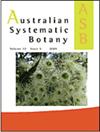Genetic variation and phylogeography of the Australian and New Zealand fern Asplenium flabellifolium (Aspleniaceae)
IF 1.6
3区 生物学
Q4 EVOLUTIONARY BIOLOGY
引用次数: 5
Abstract
Abstract. Asplenium flabellifolium Cav. is a cytologically variable Australian and New Zealand fern. Here, we sequence chloroplast trnL-trnF and rps4-trnS from samples throughout its range to provide the first phylogeographic investigation of a fern common in both countries. Twenty-three haplotypes were detected, which formed six haplogroups in a network. Australian specimens were placed in all haplogroups. The placement of New Zealand haplotypes in five of the haplogroups suggests that this species has dispersed across the Tasman Sea at least five times. Sexually reproducing plants of lower ploidy, detected only in south-eastern Australia, contained haplotypes from the two haplogroups that are successive sisters to the remaining diversity in the phylogeny. This likely suggests that A. flabellifolium was originally a sexually reproducing species in south-eastern Australia and spread to the rest of its distribution where apomictic plants dominate. More than one haplogroup was detected in several areas across its distribution, suggesting that these areas were colonised several times. Other areas harboured several haplotypes from a single haplogroup or haplogroups not recovered elsewhere, indicating possible long-term persistence in these areas. Haplotypes and morphological features were not found to be exclusive to either breeding system or ploidy and no taxonomic revision is proposed.澳大利亚和新西兰羊齿蕨(羊齿蕨科)的遗传变异和系统地理学研究
摘要扇叶阿斯彭。是一种细胞学可变的澳大利亚和新西兰蕨类植物。在这里,我们对整个范围内的样品中的叶绿体trnL-trnF和rps4-trnS进行了测序,以首次对两国常见的蕨类植物进行系统地理学研究。检测到23个单倍型,在一个网络中形成了6个单倍组。澳大利亚标本被归入所有单倍群。新西兰单倍型在其中五个单倍型群中的分布表明,该物种至少五次分散在塔斯曼海。仅在澳大利亚东南部检测到的较低倍性的有性繁殖植物,包含两个单倍群的单倍型,这两个单倍型是系统发育中剩余多样性的连续姐妹。这可能表明A.flabellifolium最初是澳大利亚东南部的一个有性繁殖物种,并传播到其分布的其他地区,在那里无融合生殖植物占主导地位。在其分布的几个地区发现了不止一个单倍群,这表明这些地区曾被多次殖民。其他地区有来自单个单倍群的几个单倍型,或者其他地方没有恢复的单倍群,这表明这些地区可能长期存在。单倍型和形态特征并不是育种系统或倍性独有的,也没有提出分类学修正。
本文章由计算机程序翻译,如有差异,请以英文原文为准。
求助全文
约1分钟内获得全文
求助全文
来源期刊

Australian Systematic Botany
生物-进化生物学
CiteScore
3.10
自引率
12.50%
发文量
12
审稿时长
>12 weeks
期刊介绍:
Australian Systematic Botany is an international journal devoted to the systematics, taxonomy, and related aspects of biogeography and evolution of all algae, fungi and plants, including fossils. Descriptive taxonomic papers should normally constitute a comprehensive treatment of a group. Short papers on individual species and nomenclatural papers must contain significant new information of broader interest to be considered. The prestigious L.A.S. Johnson Review Series is published. Other review articles will also be considered. All papers are peer reviewed.
Australian Systematic Botany is published with the endorsement of the Commonwealth Scientific and Industrial Research Organisation (CSIRO) and the Australian Academy of Science.
 求助内容:
求助内容: 应助结果提醒方式:
应助结果提醒方式:


